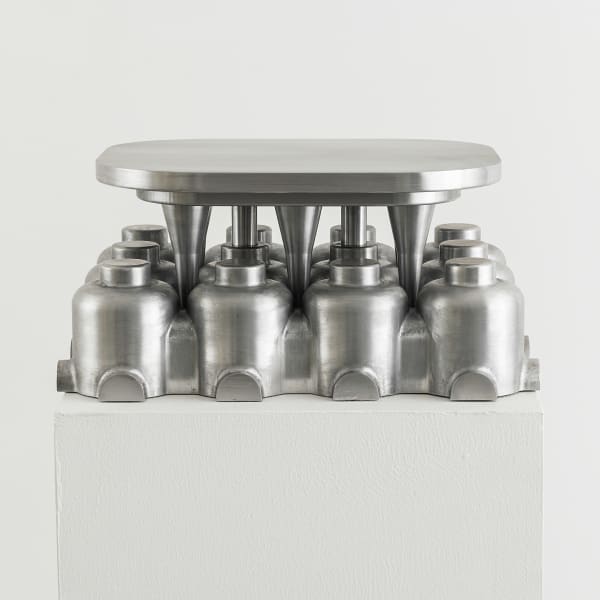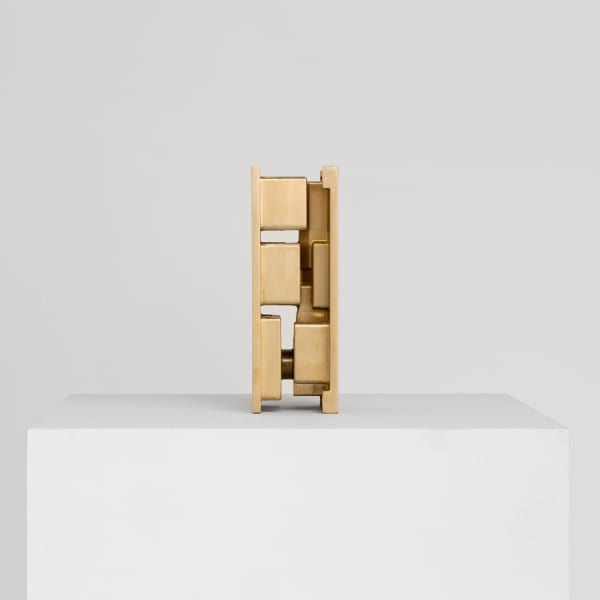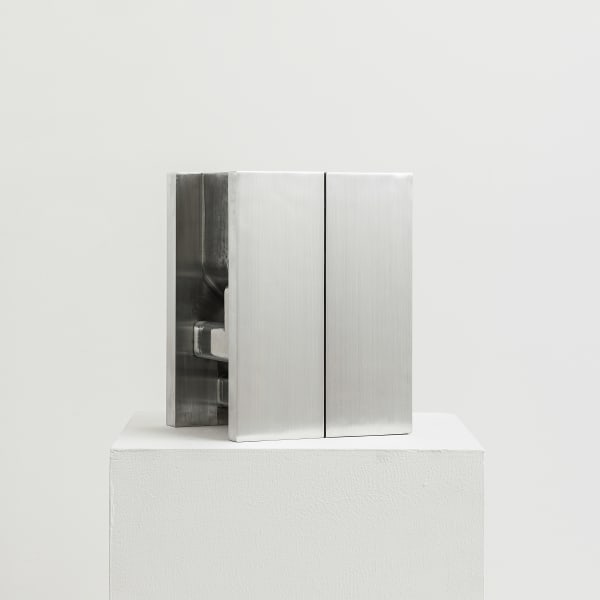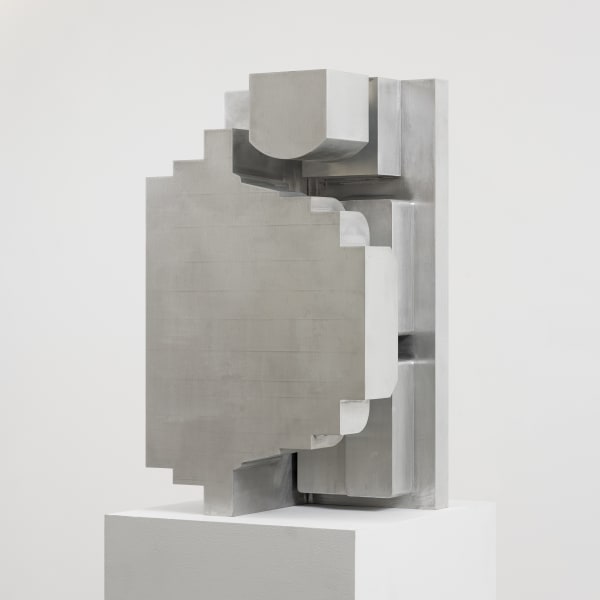WU Houting: 2066: Solo Exhibition
Past exhibition
Installation Views
Overview
From May 13, 2023, to June 30, 2023, Don Gallery will host a solo exhibition titled “2066” for artist WU Houting, which will present 15 of the artist’s recent sculptures. The spatiality, timeliness, and limits of the sculptures’ shapes reveal the gaps created during the production and shipment of everyday commodities and products. This space is delineated by the physical, ephemeral space occupied by exquisite structures of utensils and packaged objects.
The concept of "gap" first appeared in WU Houting's 2014 canvas oil paintings, which depicted the fissures and crevices of natural rock. Since 2017, WU’s study of “gap” has taken a marked metaphoric and symbolic turn, focusing on consumer goods and the hidden and oft-overlooked spaces that lie between the outer packaging and the actual object. His works are based on the product’s external structure, the packaging materials, and the gaps between the product and the packaging. WU disassembles, cuts, juxtaposes, and reconstructs these three elements, endowing his work with the shapes of standardized modern industrial manufacturing. Through reconstruction, the functionalist design concept of “form follows function” is divorced from the product’s original function. The shape of WU’s works does not reflect the essence or function of the packaging or commodities, and rather, they manifest the organic and inorganic, tangible and metaphysical forms of man-made objects.
Using and referencing commodities and products in sculpture can be traced back to the object sculpture of the early 1980s, which arose as a contemporary response to the concept of the ready-made commenting on the power and ubiquity of global marketing and the world of consumer goods (Judith Collins). Based on either the aesthetic function or an interpretation of social culture, artists directly use, copy, or transform everyday objects. In the UK, object sculpture revisits broken, discarded, and anonymous items- Richard Wentworth referred to as “the archaeology of the dust bins”, which challenged ideas about authenticity and originality in art.
WU’s work is closely related to object sculpture, but the “object” of his work borrows the forms of both products and packing materials. At the same time, the product itself is removed from the sculpture, the space it once occupied is reorganized, and its function ceases to exist. The artist also embeds the concepts of “nothingness” and “gap” into the context of his work, imbuing his work with an “aura” that takes it beyond the scepticism of authenticity. Here, “nothingness” and “gap” refer to the spaces between the packaging material, fillers, and products. The relationship between “nothingness” and “gap” is both explicit and hidden, with the former being spatial and the latter being visual. Before the packaging is opened, the form of “nothingness” consists of the space between the product and the package, and overlaps with a visual “gap.” When the product is removed from the package, the “gaps” disappear, and “nothingness” enters the wider space around it. When the commodity product reaches its terminal destination, “nothingness” changes form, while the “gaps” allude to the fate of the temporary and fleeing objects. Here, WU halts the rise of entropy that occurs after unpacking, and “nothingness” and the “gaps” are solidified on the brink of chaos.
WU’s “gaps” have evolved from those found in nature to those found in packaging for commodity products. Gaps in rock formations and mountains speak to longevity and growth, while these artificial gaps only exist to protect and store products while they are being transported – they are temporary, and ultimately formless. WU sculpts objects with auras. In dismantling and exposing the restrictive environments inhabited by commodity products, WU reflects the mythos of production and life in contemporary society. He reshapes and recreates the gaps as a form of rebellion against time, and transfers eternity to ephemeral forms.
The concept of "gap" first appeared in WU Houting's 2014 canvas oil paintings, which depicted the fissures and crevices of natural rock. Since 2017, WU’s study of “gap” has taken a marked metaphoric and symbolic turn, focusing on consumer goods and the hidden and oft-overlooked spaces that lie between the outer packaging and the actual object. His works are based on the product’s external structure, the packaging materials, and the gaps between the product and the packaging. WU disassembles, cuts, juxtaposes, and reconstructs these three elements, endowing his work with the shapes of standardized modern industrial manufacturing. Through reconstruction, the functionalist design concept of “form follows function” is divorced from the product’s original function. The shape of WU’s works does not reflect the essence or function of the packaging or commodities, and rather, they manifest the organic and inorganic, tangible and metaphysical forms of man-made objects.
Using and referencing commodities and products in sculpture can be traced back to the object sculpture of the early 1980s, which arose as a contemporary response to the concept of the ready-made commenting on the power and ubiquity of global marketing and the world of consumer goods (Judith Collins). Based on either the aesthetic function or an interpretation of social culture, artists directly use, copy, or transform everyday objects. In the UK, object sculpture revisits broken, discarded, and anonymous items- Richard Wentworth referred to as “the archaeology of the dust bins”, which challenged ideas about authenticity and originality in art.
WU’s work is closely related to object sculpture, but the “object” of his work borrows the forms of both products and packing materials. At the same time, the product itself is removed from the sculpture, the space it once occupied is reorganized, and its function ceases to exist. The artist also embeds the concepts of “nothingness” and “gap” into the context of his work, imbuing his work with an “aura” that takes it beyond the scepticism of authenticity. Here, “nothingness” and “gap” refer to the spaces between the packaging material, fillers, and products. The relationship between “nothingness” and “gap” is both explicit and hidden, with the former being spatial and the latter being visual. Before the packaging is opened, the form of “nothingness” consists of the space between the product and the package, and overlaps with a visual “gap.” When the product is removed from the package, the “gaps” disappear, and “nothingness” enters the wider space around it. When the commodity product reaches its terminal destination, “nothingness” changes form, while the “gaps” allude to the fate of the temporary and fleeing objects. Here, WU halts the rise of entropy that occurs after unpacking, and “nothingness” and the “gaps” are solidified on the brink of chaos.
WU’s “gaps” have evolved from those found in nature to those found in packaging for commodity products. Gaps in rock formations and mountains speak to longevity and growth, while these artificial gaps only exist to protect and store products while they are being transported – they are temporary, and ultimately formless. WU sculpts objects with auras. In dismantling and exposing the restrictive environments inhabited by commodity products, WU reflects the mythos of production and life in contemporary society. He reshapes and recreates the gaps as a form of rebellion against time, and transfers eternity to ephemeral forms.
Works
-
 WU HoutingException- 161 破格– 161, 2019Aluminum 铝33.2 × 29.1 × 16.1(H) cmUnique 唯一版本
WU HoutingException- 161 破格– 161, 2019Aluminum 铝33.2 × 29.1 × 16.1(H) cmUnique 唯一版本 -
 WU HoutingException- 166 破格– 166, 2023Aluminum 铝36 × 27 × 16.6(H) cmUnique 唯一版本
WU HoutingException- 166 破格– 166, 2023Aluminum 铝36 × 27 × 16.6(H) cmUnique 唯一版本 -
 WU HoutingException- 195 破格– 195, 2022Aluminum 铝30 × 19.5 × 22.5(H) cmUnique 唯一版本
WU HoutingException- 195 破格– 195, 2022Aluminum 铝30 × 19.5 × 22.5(H) cmUnique 唯一版本 -
 WU HoutingException-200 破格-200, 2023Brass 黄铜10.5 x 7 x 20 cm
WU HoutingException-200 破格-200, 2023Brass 黄铜10.5 x 7 x 20 cm -
 WU HoutingException- 260 破格– 260, 2023Aluminum 铝19.8 × 17.6 × 26(H) cmUnique 唯一版本
WU HoutingException- 260 破格– 260, 2023Aluminum 铝19.8 × 17.6 × 26(H) cmUnique 唯一版本 -
 WU HoutingException- 330 破格– 330, 2022Aluminum 铝33 × 33 × 23(H) cmUnique 唯一版本
WU HoutingException- 330 破格– 330, 2022Aluminum 铝33 × 33 × 23(H) cmUnique 唯一版本 -
 WU HoutingException- 506 破格– 506, 2019Aluminum 铝22.3 × 13.4 × 50.6(H) cmUnique 唯一版本
WU HoutingException- 506 破格– 506, 2019Aluminum 铝22.3 × 13.4 × 50.6(H) cmUnique 唯一版本 -
 WU HoutingException- 600 破格– 600, 2022Aluminum 铝35 × 24 × 60(H) cmUnique 唯一版本
WU HoutingException- 600 破格– 600, 2022Aluminum 铝35 × 24 × 60(H) cmUnique 唯一版本



























